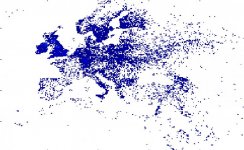Hi Archetype0ne,
Would appreciate it very much if you could apply your deductive reasoning to the diversity of L283 clades with Albanian flags vis a vis the timeline.
I will try for clades with YFULL Albanian "flag".
First, I really want to precise that this approach to track haplogroup make sense only when there is an "expansion" of the population.
Basically, between two demographic "booms" we are blind. Thus, for specific entrance in Albania sometimes the time-range will be wide.
I consider that the likely place the origin of J-L283 in 3500BC is around the Black Sea in the Roumania/Ukrainia/Moldova sector (nearby the rumored Eneolithic Moldovan sample). After, I think it migrated toward Central Europe/North Balkan where it started most of its expansion (post J-Z597 stage after 2500BC).
The clades will be analyzed in such context ("Out of Central Europe" model).
Overall, for J-L283, some stuff are happening between 2400 and 1900BC ... It is hard to say which culture(s) was involved in this diffusion stage. Then a lot of stuff happened around 1200BC in location matching Urnfielders.
Some stuff also happened in Southern Europe around 1800-1700BC for one clade (J-Y15058), I don't have a well defined opinion about what event/culture are concerned.
Albanian flaged (YFull) subclades of J-L283:
--> J-Z622 > J-YP91 > J-YP61 > J-YP29 > J-YP181 > J-FT196148 :
??? Too few samples, maybe some Iron-Age population movements or anything later.
--> J-Z622 > J-Z600 > J-Z2509 > J-Z585 > J-Z615 > J-Z597 > J-Y146400 > J-FGC64043 > J-FT29034 :
??? Too few samples, could be related to anything from 900BC to modern time.
--> J-Z622 > J-Z600 > J-Z2509 > J-Z585 > J-Z615 > J-Z597 > J-Z2507 > J-Y15058 > J-Z40052 > J-Z40054 :
??? Rare clade, arrived sometime after 1800BC.
--> J-Z622 > J-Z600 > J-Z2509 > J-Z585 > J-Z615 > J-Z597 > J-Z2507 > J-Y15058 > J-Z38240 > J-Z38241 > J-PH1602 > J-PH502 > J-Y40288 :
Maybe related to Urnfield expansion around 1100BC, entry in Albania could date from later times and be related to population movement between 1100BC and 500AD.
--> J-Z622 > J-Z600 > J-Z2509 > J-Z585 > J-Z615 > J-Z597 > J-Z2507 > J-Z638 > J-Y21045 > J-PH4679 :
Early expansion in Albania around 1800BC or Urnfield expansion around 1200BC. Hard to follow between 1800BC and 1200BC. Intense diffusion of J-PH1751 subclade (around 750AD, maybe someone with a good knowledge of Albania history can identify which could be the related event). It is probably the most secure Haplogroup for an old presence in Albania (entrance in 1200BC or before)
--> J-Z622 > J-Z600 > J-Z2509 > J-Z585 > J-Z615 > J-Z597 > J-Z2507 > J-Z638 > J-Z1297 > J-Y27522 > J-Y23094 > J-Y182183 > J-Y36202 > J-Y80036 > J-Y226157 > J-Y182854 :
Likely linked to Urnfield expansion. Arrived around Albania between 1000BC and 1450AD.
--> J-Z622 > J-Z600 > J-Z2509 > J-Z585 > J-Z615 > J-Z597 > J-Z2507 > J-Z638 > J-Z1297 > J-Y27522 > J-Y23094 > J-Y86181 :
Possibly arrived with an Urnfield movement of population, established in Albania or very nearby prior 900BC.
--> J-Z622 > J-Z600 > J-Z2509 > J-Z585 > J-Z615 > J-Z597 > J-Z2507 > J-Z638 > J-Z1297 > J-Z2195 > J-Y21878 > J-FT29003 :
Rare subclade, MRCA in 1450AD. Arrived between 1700BC and 1450AD.
--> J-Z622 > J-Z600 > J-Z2509 > J-Z585 > J-Z615 > J-Z597 > J-Z2507 > J-Z638 > J-Z1297 > J-Z2195 > J-Y21878 > J-CTS11100 > J-Y166564 > J-FT125046 :
Likely related to Urnfield expansion. Exact date of entrance in Albania somewhere between 1300BC and 600AD. Hard to tell if presence in Albania pre-date or post-date Roman times.
--> J-Z622 > J-Z600 > J-Z2509 > J-Z585 > J-Z615 > J-Z597 > J-Z2507 > J-Z638 > J-Z1297 > J-Z2195 > J-8421 > J-Z631 > J-Y155546 :
Likely Celtic expansion or movements inside Roman Empire
--> J-Z622 > J-Z600 > J-Z2509 > J-Z585 > J-Z615 > J-Z597 > J-Z2507 > J-Z638 > J-Z1297 > J-Z2195 > J-8421 > J-Z631 > J-Y144394 :
Likely Celtic expansion or movements inside Roman Empire
--> J-Z622 > J-Z600 > J-Z2509 > J-Z585 > J-Z615 > J-Z597 > J-Z2507 > J-Z638 > J-Z1297 > J-Z2195 > J-8421 > J-Z631 > J-Z1043 :
Isolated sample, arrived there after 800BC, may be related to Celtic, Roman or something else.
--> J-Z622 > J-Z600 > J-Z2509 > J-Z585 > J-Z615 > J-Z597 > J-Z2507 > J-Z638 > J-Z1297 > J-Z2195 > J-8421 > J-Z631 > J-Z1043 > J-Z8424 > J-Z8429 :
Likely Celtic expansion or movements inside Roman Empire.
As a conclusion, "safe" old clades are J-PH4679 (at worst 1200BC) and J-Y86181 (at worst 900BC). Other clades are less clear, even those with a diffusion that seems to correlate with Urnfield expansion. This expansion was touching many territories, and therefore, for isolated clades, it is not out of the pictures that they were injected by later population movements, as we see diffusion dynamic sometimes yields to large ranges for entrance time encompassing Celtic and Roman times.
Plus, J-PH1751 (subclade of J-PH4679) experienced a big diffusion circa 750AD, which may be related to some historical event in Albania.






